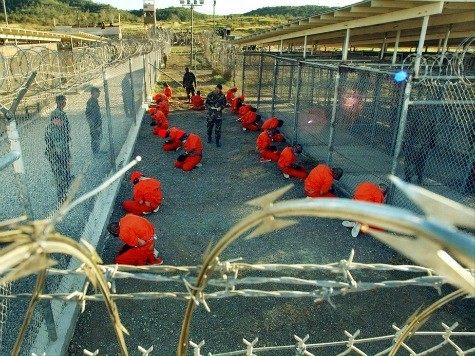WASHINGTON — The Obama administration, coming a step closer to reaching its goal of shutting down the Guantanamo Bay prison, has released five Yemenis from the detention center.
According to the Pentagon, four were sent to Oman, which borders Yemen, and one to Estonia, marking the first time that either country has taken in Guantanamo Bay detainees for resettlement.
The transfer brings down the Guantanamo prison population to 122.
Prisoners from Yemen, where the Yemeni government is battling Al-Qaeda in the Arabian Peninsula (AQAP), make up the majority of the detainees and the bulk of the 54 who have been cleared for transfer.
All five men were held as suspected al-Qaeda fighters for more than a dozen years. They were cleared for release by the Obama administration in 2009.
“We are committed to closing the detention facility. That’s our goal and we are working toward that goal,” said Ian Moss, a spokesman for the U.S. State Department on Guantanamo issues.
Last month, The Long War Journal reported that even those detainees who have been “cleared for release” may still pose a threat to the U.S. “It is often reported that detainees, such as the four transferred to Afghanistan [in December], have been ‘cleared for release.’ The implication is that they had been ‘cleared’ of any wrongdoing and their release is risk-free,” noted the Journal. “But this is not true.”
The recent transfer has unleashed a war of words over the recidivism rate of Guantanamo detainees who have returned to the fight against the U.S. after being released. One person returning to the fight can pose a threat to the U.S., as demonstrated by the former Guantanamo detainee who is reportedly recruiting Afghan fighters on behalf of the Islamic State (IS, ISIS, ISIL).
Some Republicans argue that roughly 30 percent of those released have re-entered the fight, while Obama administration officials accuse the GOP of exaggerating the figure. The actual recidivism rate for Guantanamo detainees is difficult to confirm because it is based on U.S. intelligence.
In September 2014, the Director of National Intelligence (DNI) reported that as of July 15, 2014, there had been 620 prisoners released, including 107 (about 17 percent) who were “confirmed of reengaging” in terrorist activities and 77 (about 12 percent) “suspected” of doing so.
According to the DNI report, between January 2009, when Obama took office, and July 15, 2014, 88 prisoners were released, including 6 (about 7 percent) who were confirmed to have returned to the fight and 1 (about 1 percent) who was suspected of it.
Of those who are either suspected or confirmed of having returned to the battlefield, between 20 and 30, including some who have been released by President Obama, are believed to have joined either ISIS or another jihadist group in Syria.
Although the U.S. balks at sending released Guantanamo detainees to Yemen, doing so is not prohibited by law. Congressional negotiators removed a prohibition on transfers of Guantanamo Bay detainees to Yemen from the recently enacted 2015 National Defense Authorization Act (NDAA).
The ban was included in the Senate version of the bill, which is considered “must-pass” legislation.
Now, Republican senators are proposing legislation that would implement that ban for two years, prohibit the transfer of high-or-medium-risk terror suspects for the same amount of time, and repeal the law that has allowed Obama to send prisoners to foreign countries.
The GOP bill would also ban the transfer of suspected terrorists to foreign nations if there has been a confirmed case where a former Guantanamo detainee was sent there and subsequently engaged in terrorism.
President Obama vowed to close down the Guantanamo detention center upon taking office but has met resistance from Congress, which banned the transfer of any prisoner to the U.S. for any reason.
In its latest Worldwide Threat Assessment, the U.S. intelligence community referred to the Yemen-based AQAP as a “significant threat” that “remains intent on targeting the United States and U.S. interests overseas.”
The jihadist group has claimed responsibility for the Charlie Hebdo assault in France that left 12 people dead, and has been linked to two separate terrorist attacks where five other people were killed.
The Islamic State, which is no longer aligned with al-Qaeda, has been able to recruit at least one fighter from the Muslim community in Estonia, Estonian Public Broadcasting reported in November.
Reuters reported that the jihadist brothers who carried out the attack against satirical magazine Charlie Hebdo traveled to Yemen via Oman in 2011 to receive weapons training in an al-Qaeda stronghold.
The Associated Press contributed to this report.

COMMENTS
Please let us know if you're having issues with commenting.